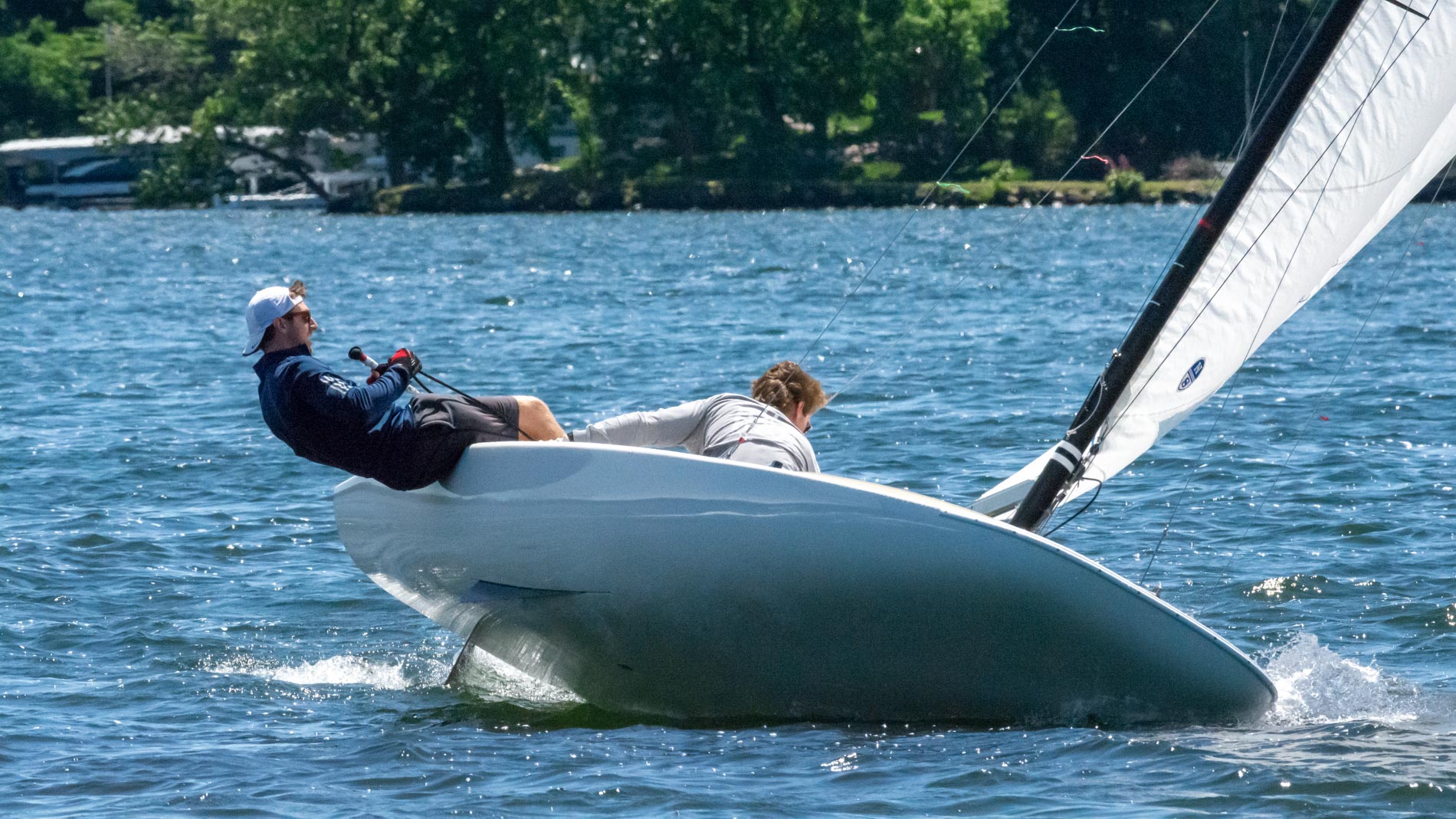You probably don’t want to imitate the picture above, but you can raise your sailing game if you learn to hike harder and smarter. Hiking takes effort, but by being fit and using proper technique you can get better results without injury and exhaustion. In this post, we compile the best tips.
This post has been updated from the original, with additional tips and links. We retained the same great featured image!
Hiking – What the Data Shows
John Loe and Val Smith, two high level sailors, measured the effectiveness of various hiking techniques in a Sailing World article. This article was written for keelboats with legs either in the boat or over the rail, but two data points are useful to small-boat sailors.
- Hard but sustainable hiking, including getting the buttocks outside of the rail, gives you about 15% more righting moment compared to relaxed hiking. Based on this, a 175 lb. sailor hiking hard could achieve as much righting moment as a relaxed 200 lb. sailor!
- Hiking is more effective with the boat flat compared to heeled up. It may be more effective to depower the sails to flatten the boat than to have the entire crew exhausting themselves.
Hiking Techniques from Nick Thompson and Steve Cockerill
Nick Thompson, Laser World Champion, and Steve Cockerill, high level sailor and coach, have each produced videos showing techniques to hike harder and smarter. Key points in these videos include:
Adjust Straps
Hiking strap height should allow you hike with relatively straight legs, so that your calves and upper legs are in contact with the deck. This allows you to feel the boat and transmit your body movement to it. If the strap is too tight or too loose you will also tend toward bent leg hiking, which is less desirable as explained below. Adjust your straps before you go out.
Ankle Position
You want a neutral ankle position. Too much flex makes you bend your knees. Too much extension puts load on the muscles around your shins.
Straighter Knees
Use your quadriceps to straighten your legs and minimize the gap between your knees and the deck. This raises your buttocks, reduces load on your legs at the rail, and also reduces the chance of long-term knee injury. Cockerill discusses the need to balance muscle development between the quadriceps and the lateral and oblique knee muscles to avoid pulling the knee cap out of line.
Lean Out, Flat Back
For more leverage and to maintain spine health, lean out with your back flat. Get your shoulders further out than your hips. Use your core to sustain this position. If your core is not strong enough, you will eventually slump, so strengthen it as discussed below.
Hike from the Toes?
The experts are somewhat divided on this. Thompson and Cockerill do not show toe hiking in their videos. However, we’ve seen other articles pointing out that you can get an extra inch or two of leverage with toe hiking. See the fitness section for conditioning tips for the ankles.
Fitness
Leg Extension Strength
We discussed the importance of leg extension strength in Three Fitness Measures of Winning Sailors. We also found another study in the European Journal of Applied Physiology showing leg extension strength and quadriceps isometric strength as the most important for hiking fitness.
In Top Sailing Fitness Principles and Exercises, we recommended the following exercises for leg extension strength:
- Leg extensions on a machine or squats with leg curls for muscle balance
- Hiking on a bench or ball
- Cycling or rowing
Hiking Bench
A hiking bench is a great way to train. We found a great article on Improper Course. This is worth reading, because it reinforces many of the points in this post, and also shows you how to build your own bench.
Ankle Exercises for Toe Hiking
Sailing Scuttlebutt published an article on exercises for toe hiking. It suggests stretching the ankles, swimming with fins, and even (gulp!) ballet.
Hiking Aids
RRS 49.1 states, “Competitors shall use no device designed to position their bodies outboard, other than hiking straps and stiffeners worn under the thighs.” Case 4 in the Casebook states that a competitor may hold a sheet when positioned outside the rail, provided Rule 49 is complied with. Some classes, such as the Flying Scot allow the crew to hold a hiking line.
Hiking pants with battens/pads or padded hiking shorts make it easier to hike for long periods. We suggest trying Rooster Sailing Hiking Pants or Gill Racing Shorts.
Hiking downwind requires tighter hiking straps. It would be great to have straps that you could easily adjust while sailing. However, most classes do not allow straps that are adjustable while sailing. The Laser class rules do allow this. Here’s a video from Rooster Sailing showing an “on-the-fly” adjustment system in a Laser.
Related Content
Hiking Styles – The Secrets Behind Efficient and Healthy Hiking – by Steve Cockerill
Sailors Helping Sailors
Will you share your knowledge with your related Comments below?



